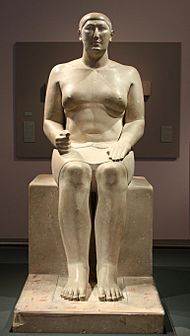Hemiunu facts for kids
Quick facts for kids
Hemiunu
|
|||||
|---|---|---|---|---|---|
| Hm-ỉwnw Priest of Iunu
|
|||||

Statue of Hemiunu at the Pelizaeus Museum, Hildesheim, Germany, his feet rest on columns of hieroglyphs painted in yellow, red, brown, and black
|
|||||
| Occupation | Vizier Architect Priest |
||||
| Title | Prince of Egypt | ||||
| Parent(s) | Nefermaat and Itet | ||||
Hemiunu lived in ancient Egypt around 2570 BC. Many people believe he was the main architect who designed and oversaw the building of the Great Pyramid of Giza. This pyramid is one of the most famous structures in the world! As a vizier, Hemiunu was like a prime minister. He held a very powerful position in the king's court and was in charge of all the king's building projects. His tomb is located very close to Khufu's pyramid.
Hemiunu's Life
Hemiunu was the son of Prince Nefermaat and his wife, Itet. He was also the grandson of King Sneferu. This made him a relative of Khufu, the king who ordered the Great Pyramid to be built. Hemiunu had several brothers and three sisters.
In his tomb, Hemiunu is called a "hereditary prince" and a "count." These were important titles. On a statue found in his tomb, he is also called "king's son of his body." This means he was a true royal family member. He was also called "chief justice" and "vizier." These titles show how powerful and important he was in ancient Egypt.
Hemiunu's Tomb
Hemiunu's tomb is located very close to Khufu's pyramid. Inside, there are reliefs, which are carvings that stick out from the stone, showing his image. Some stones from his tomb, called a mastaba, have dates that refer to the reign of King Khufu.
Hemiunu's Statue
A famous statue of Hemiunu can be found at the Pelizaeus Museum in Hildesheim, Germany. This statue was found in a hidden room called a serdab inside Hemiunu's tomb. An archaeologist named Hermann Junker discovered it in 1912.
Even though ancient robbers had damaged the statue, it is still very well-preserved. They broke off an arm and the head while trying to steal valuable parts. The head has been fixed using another carving of Hemiunu as a guide. The statue is special because it looks very realistic. It shows Hemiunu as an obese man, which was unusual for statues of important people in ancient Egypt. Usually, royal figures were shown with perfect, idealized bodies.
Images for kids
See also
 In Spanish: Hemiunu para niños
In Spanish: Hemiunu para niños


